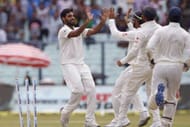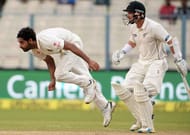Bhuvneshwar Kumar is back to his best. Twice in India’s last few Tests, he was picked ahead of other options, in conditions favouring his swing bowling; on both occasions, he bowled India to huge wins, registering 5 wicket hauls in St. Lucia and now at the Eden Gardens.
Not many bowlers have the unique distinction of having dismissed Sachin Tendulkar for a duck, long before his international debut and in the fledgling years of his domestic career.
The soft-spoken bowler from Uttar Pradesh made his first-class debut at the age of 17. At 18, the rookie handed Sachin his first duck in first-class cricket, in the Ranji Trophy final of 2008-09, and at 22, he was swinging the new ball for India. Hailing from Meerut, Bhuvi belongs to the UP lineage of military medium paced swing bowlers – similar to fellow town mate, senior teammate and Indian cricketer Praveen Kumar.
He made his international debut against Pakistan in a T20I in Bangalore. Handed the new ball in his debut game, Bhuvi exhibited a master-class in setting up a batsman with swing, angling the ball away from the left-handed Nasir Jamshed and then getting one to jag back into the stumps to pick his first international wicket off the last ball of his first over in top flight cricket.
However, the ball of the match was one that curved in to rattle Umar Akmal’s middle stump. He eventually finished with dream figures of 3 for 9 off 4 overs on debut.
On his ODI debut, Bhuvi produced a similar peach that accounted for the off-stump of an unsuspecting Mohammad Hafeez who had least expected the ball to swing in. He had on this occasion picked a wicket off the very first ball of his ODI career.
Making an early impression in the game has always been the USP of his bowling and such achievements rightly speak of him living up to the tag. He has almost always given India early breakthroughs, but a few other shortcomings have pulled him back too; 60 wickets from 57 ODIs does no justice to his talent.
Here’s an analysis of Bhuvi’s bowling – what works for him and what doesn’t:
The Art of Swing Bowling
It’s his ability to swing the new ball appreciably that makes the Indian bowler a force to reckon with. Landing the ball on a fullish length that tempts batsmen into driving down the ground, he generates prodigious swing in both directions as well as lateral movement off the pitch to induce the edge – a much-dreaded proposition for batsmen very early in the innings.
A short, easy run-up to the crease, a high arm delivery action, and a strong wrist position – Bhuvi has one of the most simple, rhythmic and repeatable bowling actions currently in world cricket. With great wrist control of the ball, Bhuvi perfectly releases the ball with the seam upright consistently; a skill that was last seen in Sreesanth, among the Indian swing bowlers.
An upright seam allows the ball to move significantly in the air and deviate off the pitch. A close look at his records state that most of his wickets are top order batsmen dismissed cheaply off the new ball.
Accuracy and Economy in Bowling
Bhuvneshwar Kumar delivers the ball from closer to the stumps with a high arm action, cutting down on the stroke-making options of batsmen as they are forced to play the line of the ball but don’t have enough room to work with. His simple and rhythmic action allows him to bowl with considerable consistency in line and length.
As a result, accurate and economical bowling is another of Bhuvi’s forte – an ODI economy of 4.89 and T20I economy of 6.68 highlights his consistency in these aspects. What separates him from many others of his ilk is the ability to set the batsman up with tight spells of bowling.
It must, therefore, be an anomaly that he also holds the ignominious record of the second highest bowling figures in ODIs having been taken for 106 runs off his 10 overs in last year’s ODI against South Africa at Wankhede.
Stamina and Ability to bowl long spells in Tests
In the longer formats, bowling with the same intensity throughout the day and through an entire series has been an issue for Bhuvi. On the tour of England in 2014, he shouldered the bulk of the bowling responsibility on responsive surfaces and returned 19 wickets in 5 Tests, a record for most wickets in a Test series for India against England in England.
While he had a very productive tour ultimately, the signs of wear was too evident by the end of the series; the pace dropped, consistency wavered and later injuries set in – a troubled ankle forced him out of reckoning for most part of the remaining season, including the tour of Australia and the ODI World Cup.
As much as on skills, Bhuvneshwar will need to work on his fitness if he is to bowl long spells on a consistent basis, survive the rigours of Test cricket and build a long lasting career.
Swing vs. Pace Conundrum
For someone with a wiry frame and who has always bowled in the early 130s ,relying on his ability to beat the batsmen with movement than sheer pace, it is a remarkable achievement that Bhuvi has added a few extra yards of pace to his bowling recently.
He has now started bowling in the mid-130s and above, even touching 140kmph on occasions. Swing is always a sticky wicket to contend with, for most modern batsmen who struggle against it, but when swing combines with decent pace, the potency doubles.
A self-realisation along those lines urged him to work up his pace without comprising on his biggest asset – swing. Bhuvi attributes this turnaround to strength training and a conscious attempt to widen the scope of his bowling so that he can feature consistently in the team, in Test cricket as well as in batsmen-friendly conditions.
To Bhuvi’s credit, he also realises swing will remain his prime weapon and doesn’t want to lose his way like many others in the past.
Effectiveness affected by conditions
So far, he has stuck around with the squad, and the Indian team management has chosen him in the final XI by the demands of the conditions. In helpful conditions assisting swing, Bhuvi can be a handful.
Nonetheless, on belters requiring bowlers to bend their backs to extract something from the surface, he is very prone to underwhelming returns – his figures in the Wankhede ODI against South Africa being a prime example.
He was Dhoni’s go-to man in England’s swinging conditions, but hardly got a game on the hard, bouncy tracks in Australia, and is not the preferred choice on the slow and low sub-continental surfaces. When India played on such tracks in the previous season, the likes of Ishant, Shami, Umesh and Aaron were ahead in the pecking order.
With Bhuvi’s improved fitness and increased pace, he will hope to pin down his spot in the bowling line-up.
Death over bowling
Probably the most significantly improved aspect in his bowling in recent years has to be his bowling at the death in limited-overs cricket. Under Dhoni, the specialist new ball bowler hurriedly finished off his quota of overs in the first half of an innings, a norm in the nascent stages of his career.
However, in the last couple of seasons, his IPL stint with Sunrisers Hyderabad has seen a marked improvement in this aspect of his bowling.
As SRH’s premier bowler, Bhuvi has had to bowl at the death and it seems like he has taken the opportunity to work on his shortcomings.
Combined with increased air speed, Bhuvi now has added a deadly yorker in his armoury and picked a lot of death over wickets with it.
He has not had many opportunities in Indian colours since his return from injury but has started bowling more in the later stages of the innings in ODIs and T20Is.
Follow IPL Auction 2025 Live Updates, News & Biddings at Sportskeeda. Get the fastest updates on Mega-Auction and cricket news



